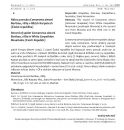| České jméno | anapa buková |
|---|
| Stupeň ohrožení | Silně ohrožený |
|---|
| Nálezy | 2 nálezů, 2 kvadrátů |
|---|
| První nález |
1992, V. Růžička, Růžička & Antuš 1998
|
|---|
| Poslední nález |
2008
, Ivan Hadrián Tuf |
|---|
| Areál rozšíření | European - ME [Boh.] |
|---|
| Fytogeografická oblast | - Oreo (Preference: Nízká)
- Oreofytikum. Oblast extrazonální horské vegetace a květeny, tedy oblast klimaxových smrčin a vyšších horských poloh. Uměle odlesněné plochy jsou přeměněny na louky a pastviny.
|
|---|
| Původnost stanovišť | - climax (Preference: Vysoká)
- Klimaxová stanoviště, která jsou minimálně narušena činností člověka: původní horská stanoviště, původní a přirozené lesy, mokřady, rašeliniště, skalní stepi a lesostepi, váté písky, kamenité sutě, skály apod.
|
|---|
| Vlhkost stanovišť | - humid
- Vlhká. Často stanoviště s vysokou hladinou spodní vody: vlhké louky, lužní lesy, klimaxové a podmáčené smrčiny, vnitřní prostory kamenitých sutí.
|
|---|
| Stratum | - Underground (Preference: Vysoká)
- Podzemí. Nehluboké podzemní prostory (půda, nory drobných savců, hnízda mravenců, puklinové systémy, kamenité sutě), jeskyně.
|
|---|
| Osvětlení stanovišť | - dark
- Částečně má charakter mikrobiotopu: skalní výklenky, převisy pod břehy potoků a strží, nehluboké a hluboké podzemní prostory.
|
|---|
| Hojnost výskytu | - very rare
- Velmi vzácný. Druh vyskytující se na velmi malém počtu mapových polí. Výskyt je obvykle vázán na jediné pohoří či na unikátní stanoviště. I počet získaných jedinců je většinou velmi malý.
|
|---|
| Nadm. výška | 500-750 |
|---|




